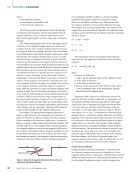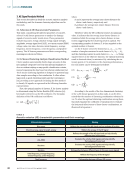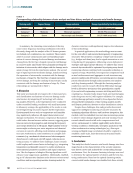where
ε is the dielectric constant,
μ is the magnetic permeability, and
σ is the electrical conductivity.
All of these provide the theoretical basis for the parame-
ter settings in the simulation software and facilitate the sub-
sequent validation of the correlation studies between the
data and the signal graphic accuracy, edge angle, and signal
changes.
Also, when examining the effect of the edge angle of a dis-
continuity on the magnetic leakage signal, it is important to
recognize that the term “magnetic leakage signal” represents
the magnetic induction strength collected at the discontinuity
by the Hall element, reflecting the presence and location of the
discontinuity. The magnetic field strength, in turn, is usually
characterized by the magnetic induction strength, while the
variation and distribution of the magnetic field are described
by the gradient and curvature. From a physical perspective, the
gradient reflects the speed and direction of change in magnetic
field strength in space, serving as the maximum derivative of
a multivariate function in a specific direction, represented as
a direction vector. Curvature, on the other hand, is used in
mathematics to measure the degree of curvature of curves or
surfaces. In the magnetic environment, it describes the curva-
ture of magnetic field lines in space for example, the curvature
of the magnetic field lines around the edges of a magnet is
large, while the curvature in a region of uniform magnetic field
strength is small. The rate of change and degree of curvature
of the magnetic field strength are reflected by the gradient and
curvature, which in turn reveal the image characteristics of
the discontinuity’s presence (Long et al. 2021 ZhongCai et al.
2015). In other words, the edge angle, as a characteristic of the
discontinuity, affects the magnetic field gradient and curvature,
which change with the edge angle, ultimately influencing the
magnetic field strength and the acquired signal curve.
According to the principle that magnetic refraction is
similar to light refraction, the propagation and refraction of
magnetic field lines in different media (at the discontinuity)
behave similarly to the refraction of light waves. As shown in
Figure 1, consider a right-angled trapezoidal discontinuity with
an edge angle of 63° as an example. When transitioning from
one magnetic medium to another, the magnetic field lines at
the interface will suddenly change. Magnetic field lines are uni-
formly distributed within the same medium, but when travel-
ing through two media, a discontinuity occurs at the interface,
resulting in refraction. When magnetic field lines transition
from a high-permeability medium to a low-permeability
medium at the interface, they bend toward the normal
(Kim 2012 Assylbekov and Yang 2015). This indicates that
the magnetic field lines are horizontal within the ferromag-
netic sample and become perpendicular to the surface of the
sample when they enter the air. Therefore, the refraction angle
equation can be derived from the magnetic field line schematic
shown in Figure 1:
(6) n1sinθ = n2sinθ2
(7) n = √
_εμ
(8) θ1 = π
2
− α
The relationship between the magnetic field refraction
angle and the edge angle can be derived from the following
equation:
(9) θ2 =arcsin
(
n1
n2 sin[π
2
− α])
where
Equation 6 is Snell’s law,
n1 and 2 are the refractive indices of two different media,
θ1 is the angle of incidence,
θ2 is the angle of refraction and
Equation 7 is the expression for the refractive index, where
ε is the permittivity and is the permeability, which is
affected by the DC magnetization.
Equations 8 and 9 express the relationship between the
magnetic field line incidence angle and the edge angle, and
the magnetic field line refraction angle and the edge angle,
respectively. Here, represents the angle between the direc-
tion of the magnetic field line and the boundary of the dis-
continuity, i.e., the edge angle, as shown in Figure 1. When
varies from 0° to 90°, ( – α decreases as increases, and
similarly sin( – becomes smaller. Therefore, according to
Equation 9, the refraction angle 2 also decreases. The change
in the direction of the magnetic field lines depicted in Figure 1
suggests that as 2 decreases, the curvature of the magnetic
field lines increases, potentially resulting in denser magnetic
field lines nearby. This indicates an increase in magnetic field
strength in the region and an increase in the strength of the
collected signal. Additionally, if the curvature of the magnetic
field lines changes, the location of the peak point of the
magnetic leakage signal will also shift. To confirm this, we will
use simulations and experiments for further validation.
Finite Element Model
Leakage magnetic detection technology is a relatively static
low-frequency magnetization process, classified as a “static
magnetic field” problem. In this paper, COMSOL finite element
software is used to build a two-dimensional simulation model
for discontinuity leakage detection, to study changes in the
ME
|
MAGNETICLEAKAGE
Air
Magnetic field lines θ
1
θ
2
n
1
n
2 α
Figure 1. Schematic of magnetic refraction at the interface of a
trapezoidal shaped discontinuity.
32
M AT E R I A L S E V A L U AT I O N • M AY 2 0 2 5
ε is the dielectric constant,
μ is the magnetic permeability, and
σ is the electrical conductivity.
All of these provide the theoretical basis for the parame-
ter settings in the simulation software and facilitate the sub-
sequent validation of the correlation studies between the
data and the signal graphic accuracy, edge angle, and signal
changes.
Also, when examining the effect of the edge angle of a dis-
continuity on the magnetic leakage signal, it is important to
recognize that the term “magnetic leakage signal” represents
the magnetic induction strength collected at the discontinuity
by the Hall element, reflecting the presence and location of the
discontinuity. The magnetic field strength, in turn, is usually
characterized by the magnetic induction strength, while the
variation and distribution of the magnetic field are described
by the gradient and curvature. From a physical perspective, the
gradient reflects the speed and direction of change in magnetic
field strength in space, serving as the maximum derivative of
a multivariate function in a specific direction, represented as
a direction vector. Curvature, on the other hand, is used in
mathematics to measure the degree of curvature of curves or
surfaces. In the magnetic environment, it describes the curva-
ture of magnetic field lines in space for example, the curvature
of the magnetic field lines around the edges of a magnet is
large, while the curvature in a region of uniform magnetic field
strength is small. The rate of change and degree of curvature
of the magnetic field strength are reflected by the gradient and
curvature, which in turn reveal the image characteristics of
the discontinuity’s presence (Long et al. 2021 ZhongCai et al.
2015). In other words, the edge angle, as a characteristic of the
discontinuity, affects the magnetic field gradient and curvature,
which change with the edge angle, ultimately influencing the
magnetic field strength and the acquired signal curve.
According to the principle that magnetic refraction is
similar to light refraction, the propagation and refraction of
magnetic field lines in different media (at the discontinuity)
behave similarly to the refraction of light waves. As shown in
Figure 1, consider a right-angled trapezoidal discontinuity with
an edge angle of 63° as an example. When transitioning from
one magnetic medium to another, the magnetic field lines at
the interface will suddenly change. Magnetic field lines are uni-
formly distributed within the same medium, but when travel-
ing through two media, a discontinuity occurs at the interface,
resulting in refraction. When magnetic field lines transition
from a high-permeability medium to a low-permeability
medium at the interface, they bend toward the normal
(Kim 2012 Assylbekov and Yang 2015). This indicates that
the magnetic field lines are horizontal within the ferromag-
netic sample and become perpendicular to the surface of the
sample when they enter the air. Therefore, the refraction angle
equation can be derived from the magnetic field line schematic
shown in Figure 1:
(6) n1sinθ = n2sinθ2
(7) n = √
_εμ
(8) θ1 = π
2
− α
The relationship between the magnetic field refraction
angle and the edge angle can be derived from the following
equation:
(9) θ2 =arcsin
(
n1
n2 sin[π
2
− α])
where
Equation 6 is Snell’s law,
n1 and 2 are the refractive indices of two different media,
θ1 is the angle of incidence,
θ2 is the angle of refraction and
Equation 7 is the expression for the refractive index, where
ε is the permittivity and is the permeability, which is
affected by the DC magnetization.
Equations 8 and 9 express the relationship between the
magnetic field line incidence angle and the edge angle, and
the magnetic field line refraction angle and the edge angle,
respectively. Here, represents the angle between the direc-
tion of the magnetic field line and the boundary of the dis-
continuity, i.e., the edge angle, as shown in Figure 1. When
varies from 0° to 90°, ( – α decreases as increases, and
similarly sin( – becomes smaller. Therefore, according to
Equation 9, the refraction angle 2 also decreases. The change
in the direction of the magnetic field lines depicted in Figure 1
suggests that as 2 decreases, the curvature of the magnetic
field lines increases, potentially resulting in denser magnetic
field lines nearby. This indicates an increase in magnetic field
strength in the region and an increase in the strength of the
collected signal. Additionally, if the curvature of the magnetic
field lines changes, the location of the peak point of the
magnetic leakage signal will also shift. To confirm this, we will
use simulations and experiments for further validation.
Finite Element Model
Leakage magnetic detection technology is a relatively static
low-frequency magnetization process, classified as a “static
magnetic field” problem. In this paper, COMSOL finite element
software is used to build a two-dimensional simulation model
for discontinuity leakage detection, to study changes in the
ME
|
MAGNETICLEAKAGE
Air
Magnetic field lines θ
1
θ
2
n
1
n
2 α
Figure 1. Schematic of magnetic refraction at the interface of a
trapezoidal shaped discontinuity.
32
M AT E R I A L S E V A L U AT I O N • M AY 2 0 2 5













































































